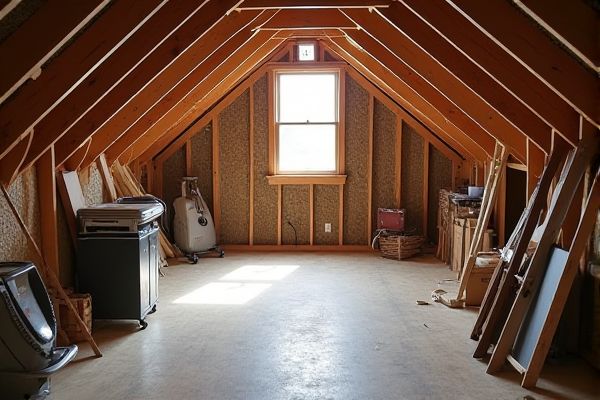
Attic storage offers easy access and keeps your belongings away from damp basement conditions, while basement storage provides more consistent temperature and humidity control but may be prone to flooding. Explore the differences to determine which storage solution best suits Your needs and home environment. Read on to learn more about attic vs. basement storage options.
Table of Comparison
| Feature | Attic Storage | Basement Storage |
|---|---|---|
| Temperature Control | Often warmer with fluctuating temperatures | Typically cooler and more stable temperatures |
| Moisture Levels | Lower humidity; risk of heat damage | Higher humidity; risk of mold and mildew |
| Accessibility | Steep stairs or ladders; less convenient | Usually easier access with regular stairs |
| Space | Limited by roof shape and insulation | Generally larger and more flexible storage area |
| Pest Exposure | Potential for rodents and insects | Possible dampness attracts pests |
| Structural Concerns | Limited floor load capacity | Stronger floors support heavier items |
| Ideal Storage Items | Lightweight, heat-resistant items | Durable, moisture-resistant items |
Introduction to Attic and Basement Storage
Attic storage offers a dry, easily accessible space ideal for seasonal items and rarely used belongings, benefiting from natural insulation that helps maintain moderate temperatures. Basement storage provides a larger, cooler environment but may require moisture control to protect your items from dampness and mold. Choosing between attic and basement storage depends on your specific needs for accessibility, climate control, and item protection.
Key Differences Between Attic and Basement Storage
Attic storage typically offers dry, warm conditions ideal for lightweight and infrequently accessed items, while basement storage often provides cooler, more humid environments that require moisture control to protect stored goods. Attics generally have limited accessibility and headroom, making them less convenient for heavy or bulky storage compared to basements, which usually offer easier access and larger space. Basement storage may pose risks of flooding and mold, necessitating proper insulation and waterproofing, whereas attics demand adequate ventilation to prevent heat buildup and structural damage.
Pros and Cons of Attic Storage
Attic storage offers easy access and utilizes otherwise unused space, making it ideal for seasonal items or rarely needed belongings. However, it often faces temperature fluctuations and potential moisture issues that can damage sensitive items, requiring proper insulation and ventilation. Weight limitations and accessibility challenges during colder months also pose significant drawbacks compared to basement storage.
Pros and Cons of Basement Storage
Basement storage offers advantages such as consistent temperature and humidity control, reducing the risk of damage to sensitive items like electronics and documents. However, basements can be prone to moisture, flooding, and mold, which may compromise the integrity of your stored belongings. You must consider proper waterproofing and ventilation to mitigate these potential downsides when choosing basement storage.
Climate and Environmental Considerations
Attic storage is often subject to extreme temperature fluctuations and humidity, risking damage to sensitive items due to heat and moisture buildup. Basement storage typically offers more stable, cooler temperatures but can be prone to dampness and mold if not properly waterproofed or ventilated. Assess your climate and ensure adequate insulation or dehumidification to protect your belongings effectively in either space.
Accessibility and Convenience Factors
Attic storage often presents challenges due to limited accessibility, steep or narrow staircases, and lower ceiling heights, making it less convenient for frequent use. Basement storage typically offers easier access with ground-level entry, more spacious layouts, and consistent temperature control, enhancing convenience for regular retrieval and organization. Both spaces require consideration of ease of access and usability depending on storage frequency and types of items stored.
Storage Safety and Security Issues
Attic storage often poses safety risks due to temperature fluctuations, potential roof leaks, and limited structural support, which can damage sensitive items. Basement storage faces concerns with moisture, mold, and pests, increasing the likelihood of item deterioration and contamination. You should assess the specific conditions of each space, ensuring adequate insulation, ventilation, and security measures to protect your valuables effectively.
Ideal Items for Attic Storage
Ideal items for attic storage include seasonal decorations, old books, and clothing not frequently used, as attics typically experience temperature fluctuations and limited humidity control. Lightweight, durable containers with airtight seals help protect belongings from dust and pests common in attic spaces. Avoid storing valuables, electronics, or sensitive documents that require stable climate conditions better suited for basement or climate-controlled storage areas.
Ideal Items for Basement Storage
Basement storage is ideal for items that require a consistent, cool, and dark environment, such as canned goods, bottled beverages, holiday decorations, and tools. Unlike attic storage, basements typically maintain stable humidity and temperature levels, reducing the risk of damage to electronics, furniture, and seasonal clothing. Properly sealed and dehumidified basements protect items from moisture-related issues like mold and mildew, making it suitable for storing sensitive documents, photo albums, and indoor plants during off-seasons.
Choosing the Right Storage Solution for Your Home
Attic storage offers a convenient, climate-controlled space ideal for seasonal items and infrequently used belongings, maximizing unused vertical space without compromising the main living areas. Basement storage provides a larger, often more secure area with stable temperature and humidity control, suitable for heavy or bulky items and long-term storage needs. Selecting the right option depends on your home's layout, accessibility preferences, and the type of items you intend to store to ensure preservation and easy retrieval.
 homyna.com
homyna.com